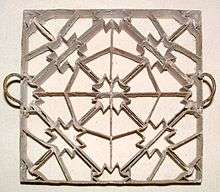Cement tile
Cement tiles or hydraulic tiles are handmade colourful tiles used as floor coverings. They appeared in Catalonia in the 1850s, and have been widely used in Europe and America.
They are mostly known throughout the world as encaustic cement tile. Like their predecessors, encaustic clay tiles, they derive their name from the term "encaustic" which is an art term used for metal enameling that uses a type of lost wax procedure. They have this name because of the intricate patterns and designs that mimic the encaustic enameling process. Cement tiles are not fired; there is no glaze layer on the surface of the tile. They derive their durability from the combination of finely dehydrated ground Portland cement layer and a more coarse layer of sand and cement. The pigment layer is hydraulically pressed into the surface and becomes a part of the tile.
History
Cement tile appeared in the 1850s in Catalonia.[1] They were exhibited in the Paris (France) International Exposition of 1867 by the Catalan company Garret & Rivet.[2]
In the United States, several sources say the first tiles were made near the country's first Portland cement plant. Around the turn of the 20th century, the tiles were very popular and were considered a high-end floor covering. It was used in thousands of landmark public buildings and palaces. Their popularity began to wane in the 1920s, but spread again in the 40s primarily in California and Florida.
Manufacture and quality

Cement tiles are made by hand, one at a time, using mineral pigments, cement, a mold, and an hydraulic press. The metal mold is handmade following specific design drawings.[3] The pigment composition is a mixture of high quality white Portland cement, marble powder, fine sand, and natural mineral colour pigments. Cement tiles being handmade are expected to have slight imperfections, which give them character and depth.
There are numerous cement tile manufacturers worldwide. The primary difference between manufacturers is the hydraulic method used. Small companies employ a hand-operated hydraulic press; the quality of the tiles varies due to inconsistent pressure. Larger manufacturers use electric-powered hydraulic presses that produce a consistently higher quality product. The higher pressure (1,500 PSI) permits a thicker pigment layer to be embedded into the cement layer. The pigment layer is usually 3–4 mm thick.[4]
Another difference is the quality of the pigments used. High quality producers use mineral-based pigments only. Non-mineral based pigments fade with age.
See also
References
- ↑ Oficios del arte
- ↑ "TREND WATCH: CEMENT ENCAUSTIC TILES". decoraid.com. Retrieved 17 October 2016.
- ↑ Prentice, Marcia (September 1, 2011). "Making of Cement Tile Using a 100+ Year Old Technique". apartmenttherapy.com. Retrieved 17 October 2016.
- ↑ "How Cement Tile is Made". cementtileshop.com. Retrieved 17 October 2016.